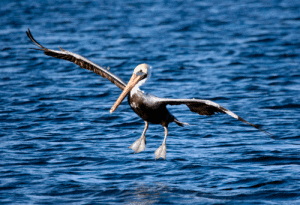 This is the story of survival and adventure for one brown pelican.
This is the story of survival and adventure for one brown pelican.
In February, 2018, Gulf Coast Wildlife Rescue (GCWR), in Angleton, TX received a brown pelican that had ingested oil and had frostbitten feet. Poor thing. But GCWR does incredible work to rehabilitate injured animals, and they went to work doing their magic on this bird. It took some time, but the pelican recovered nicely. It was healthy and ready to return to the beach.
Before releasing the bird, GCWR allowed us to place a leg band on the bird. The leg band is a metal band which the bird wears for the rest of its life. Each band has a unique number on it which allows for individual identification of birds – something like your social security number. The leg band also has the Bird Banding Lab (BBL) reporting website imprinted on it, where the band number can be submitted if the bird is ever encountered by another person.
The release of the pelican was picture perfect. It was transported to the beach near Freeport, TX in a kennel. When the kennel door was opened, the pelican hopped out and then took a couple steps. It gave a couple mighty flaps of its powerful wings and flew off over the waves, joining up with other pelicans in the area.
Usually, that’s the last we hear about any of the birds we band. However, this bird did not follow the normal script.
Fast forward to January, 2019, to the small town of Tela, on the coast of Honduras. A group of people were feeding fish to a pelican on the dock in the bay. They noticed the bird had a leg band, and it seemed to be unafraid of them. After a while, they were able to approach closer to the bird. In time, they were able to catch the pelican by hand. They read and recorded the band number, along with the reporting website from the band, then released the bird unharmed. And they eventually reported it to the BBL, who in turn notified us of the encounter. Remarkably, this is the same bird that GCWR released nearly a year earlier. How do we know?
The band number proves it.
Why is this remarkable? Well, Tela is over 1000 miles away from Freeport – straight line. But we know pelicans don’t fly in straight lines, instead they tend to stick pretty close to the coast. This bird likely flew around the Gulf of Mexico, around Mexico’s Yucatan peninsula, then along the western shoreline of the Caribbean Sea to arrive at the dock in Tela, Honduras. This route is over 2000 miles long, and the pelican completed the trip in less than a year!
Without the leg band number, there is no possible way to know the history and travels of this pelican. It shows that rehabilitated birds can survive in the wild just fine on their own. It also indicates that brown pelicans can travel long distances. However, it raises many more questions. Why did this pelican travel so far away from Freeport? Will it come back to Freeport, or will it stay in Honduras, or will it continue to wander? Why do some pelicans fly so far afield, while others apparently do not?
In any case, it is gratifying to know that this pelican survived for nearly a year after it was released. It has had quite a journey.

Kay Lookingbill is a volunteer and advisory board member at the Gulf Coast Bird Observatory, who also bands birds. The GCBO is a non-profit organization dedicated to saving the birds and their habitats along the entire Gulf Coast, and beyond into their Central and South America wintering grounds.
